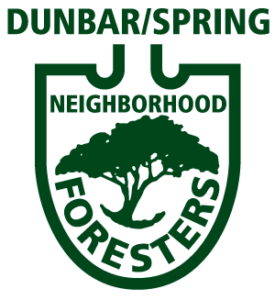You might think Brad Lancaster is pulling your leg when he tells you he’s a “neighborhood forester” in the cactus-studded desert city of Tucson.
Not at all.
Lancaster and about a dozen other residents of the Dunbar/Spring neighborhood near downtown are dead serious about their work as volunteer neighborhood foresters — dedicated to planting and maintaining native trees along the streets and properties where they live.
“It’s all about planting trees and caring for trees,” said Lancaster, an author and presenter on topics ranging from trees to rainwater harvesting. “The effect we’re going for is to have shaded streets and shaded walkways.”
He and others who take part in forestry activities in the neighborhood will lead a tree planting event beginning at 7:30 a.m. on Saturday, Nov. 18. The public is welcome.
TWO DECADES OF PLANTING
Lancaster organized the first of what has become an annual tree-planting event in 1996.
“At that time, a lot of rights-of-ways were sterile, barren places,” he said. “The streetscape wasn’t a very inviting place. We wanted to reclaim that dead space.”
Since then, volunteers, who call themselves urban neighborhood foresters, have transformed the Dunbar/Spring area into a vibrant, green landscape — planting more than 1,500 native trees such as velvet mesquites, desert ironwoods, foothills palo verdes and canyon hackberries.
The neighborhood, with about 1,300 households, is bordered by Stone Avenue on the east, Speedway on the north, railroad tracks on the west and Sixth Street on the south.
“In addition to plantings along rights of ways, we help people select and plant trees for their private properties,” Lancaster said. “We emphasize trees that will shade their homes from the morning or afternoon sun.
“We’re literally bringing the Sonoran Desert right to where we live, work and play,” said Lancaster, 50.
Residents pay for trees that are planted on their properties or along rights of way next to their properties. Prices are kept reasonable by purchasing from Trees for Tucson or a neighborhood nursery, Lancaster said.
“We’re creating a green infrastructure, a living infrastructure,” Lancaster said this week as he walked the neighborhood, stopping here and there to prune trees that had overgrown walkways. “The trees create living air conditioning, living flood control, living air and water filters and living beauty. They also contribute to traffic calming” by growing close to streets and encouraging slower driving.
He added that — possibly as a result of the greener environment — he and other residents are seeing more wildlife in the neighborhood, including coyotes, javelinas, hawks and roadrunners.
Katie Gannon, program director for Trees for Tucson and an arborist, had high praise for the foresters.
“They are a committed group of neighborhood volunteers who are passionate about planting and taking care of trees,” Gannon said. “It’s a tremendous benefit to our community.”
She said the neighborhood is a showplace for the value of trees.
“Trees supply so many benefits you can see working there,” Gannon said. “They attract wildlife, help calm traffic, and they also cool the neighborhood down.”
PLANT THE RAIN
A key rallying cry for the foresters and others in the neighborhood is “Plant the rain!”
Lancaster, author of two volumes of a book called “Rainwater Harvesting for Drylands and Beyond,” said planting the rain entails creating low-lying catchments where rainwater runoff from neighborhood streets seeps into the soil instead of flowing away.
He said he and other residents worked with the city of Tucson to get legal approval for “curb cuts” — sections of street curbs that are cut out to allow rain runoff to flow into the collection catchments.
“We don’t plant any plant until we first plant the rainwater,” he said.
“We’re taking storm runoff from the streets and turning it into a resource” — providing water for trees and other plants. “It’s planting the water into a living sponge of organic matter.
“We’re banking the water deep into the soil so we can get through dry times.”
FORESTER TRAINING
The neighborhood foresters of Dunbar/Spring provide training for aspiring foresters from their neighborhood and other areas.
Those seeking to become foresters are trained and tested on plant identification and taught skills such as pruning, Lancaster said.
“They also identify and eat at least three native plant food species” such as trees with edible flowers and beans, he said.
A section of the neighborhood’s website — tinyurl.com/dunbarforester — provides detailed information on training requirements.
See the original article here: https://tucson.com/news/local/neighborhood-foresters-work-to-beautify-their-slice-of-the-tucson-community/article_9843dcf8-dd07-5095-82cc-c12e6c10d61d.html
